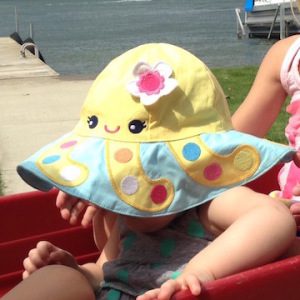Sun exposure, as with all things in pediatrics, is helpful in small doses but harmful in excess. Sunlight, in addition to containing waves that make up visible light also contains ultraviolet (or “UV”) light, with shorter wavelengths. UVA and UVB light waves penetrate the ozone layer and reach the earth’s surface (and your child’s skin).
The human body relies on sunlight for many things, from helping to regulate the sleep-wake cycle to improving our moods to converting vitamin D to its active form. However, excess exposure to UVA and UVB light is harmful and has been linked with early aging of the skin, sunburn, as well as the development of many skin cancers. It is therefore important to limit your child’s exposure to the sun. The way you accomplish this depends on the age of your child.
For babies under the age of 6 months, sun safety begins and ends with sun exposure reduction. For these young infants, shade is their best friend. When shade isn’t available, dress infants in lightweight long-sleeved shirts and pants, and have them wear brimmed hats that provide adequate coverage from the sun’s rays (as well as look cute in family photos). If necessary, you can apply a minimal amount of sunscreen to sun-exposed areas of your baby’s body and face.
Older infants and children can also reduce sun exposure by wearing clothing with a tight weave, forward-facing hats with a 3-inch brim to help shade the face, as well as sunglasses that provide protection from UVA and UVB light. The sun’s rays peak between the hours of 10 am and 4 pm, so staying in the shade during this window of time is helpful. However, full sun avoidance for these 6 hours is impractical since this is likely when your children will be competing in soccer tournaments, swimming at the pool, or playing at the beach. This is where sunscreen is your and your child’s best friend.
There are many sunscreens available but just a few key considerations when selecting one.
First, choose a sunscreen with an SPF (“sun protection factor”) 15 or greater that protects against both UVA and UVB rays, and reapply at least every 2 hours because it wears off with rubbing, sweating, or swimming.
Second, despite many creative products on the market, sunscreen lotions are the only truly effective means of protecting the skin. Sunscreen sprays provide inconsistent and often inadequate protection.
Finally, some infants and children have skin that is sensitive to some of the components of sunscreen including fragrances in certain products, para-aminobenzoic acid (or “PABA”), and several others. If you think your child may have sensitive skin or an allergy to a component of sunscreen, select a product that contains zinc oxide or titanium dioxide.
Outdoor play in the sun is an important and essential part of childhood and taking the time to protect your children’s skin is the first step!
Written by: Dr. Ben Kornfeld

